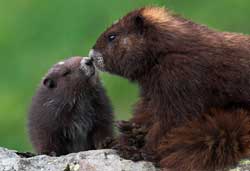“We were concerned the results would be similar to last year when no pups were born at the Mount Washington colony,” said Recovery Team Chair, Don Doyle.
With the marmots facing similar conditions this spring, the Team wanted to see if improving the spring condition of the adults, through supplemental feeding, would increase the number of successful pups weaned.
Only two colonies were accessible for testing, Mount Washington and Green Mountain. Feeders were placed near the hibernaculums as soon as the marmots emerged from hibernation and were monitored and filled as needed.
It’s impossible to say how many of the pups born were a result of the feeders, but observations at both sites point to a positive influence worth additional research. Almost half (thirty-one) of the total sixty-eight pups born in the wild were born at the two colonies with feeders.
At the Mountt Washington colony, 5 litters (totaling 17 pups) were born instead of the 3-4 litters that were expected under normal conditions. One litter was born to an 11-year old female (a very mature age for a wild marmot to have pups) and another 9-year old female produced her first litter ever!
The Green Mountain colony showed similar promise. This colony, located in the Nanaimo Lakes region of Vancouver Island, had consistently numbered less than 10 marmots. This year, multiple litters totaling 10-14 pups were observed, plus the adults – effectively doubling the colony.
While relying on supplemental feeding to increase productivity may not be practical or desirable for the long-term survival of the species, it does have practical applications if it proves to be beneficial. Additional pups can be trans-located to fledgling colonies to help them become established and the colony will also naturally disperse marmots, strengthening surrounding colonies and developing new ones.
This fall two groups of captive born marmots were released at Mount Washington to see if supplemental feeding will reduce the first year vulnerability of captive born marmots to hibernation related mortality. The next step will be to see if the survivors, preconditioned at the Mount Washington colony, have better survival than newly released marmots once they are trans-located to other colony sites.
While it may be too early for concrete conclusions, the initial observations and potential long-term applications for supplemental feeding are promising.
So, expect to see feeders on the slopes of Mount Washington again next spring. And if you’re really lucky, you may even catch sight of our uniquely Canadian marmot chomping down a hearty meal.
The Vancouver Island marmot is one of Canada’s most endangered species. Thanks to a robust captive breeding and release program the population is steadily regaining strength after near extinction in the wild in 2003.
If you would like to help the Vancouver Island marmot be restored to their habitat in the wild on Vancouver Island please adopt a marmot at www.marmots.org
